Acupuncture and Belief: Critical Analysis for Communications Course
VerifiedAdded on 2023/06/10
|5
|1555
|316
Essay
AI Summary
This essay critically examines the belief in acupuncture, addressing its effectiveness and the underlying concepts of qi energy. It explores the historical context, including its ban in China due to lack of scientific evidence, and discusses various factors influencing perceptions of acupuncture's benefits, such as test subject bias and the placebo effect. The essay references clinical studies and meta-analyses that challenge the notion of acupuncture as an effective treatment, highlighting the importance of randomized controlled trials and the potential for biased results. Ultimately, the essay concludes that current evidence is insufficient to support the belief in acupuncture's effectiveness, suggesting it should be considered an alternative treatment option rather than a scientifically proven therapy. Desklib offers a platform to explore similar essays and study resources for students.
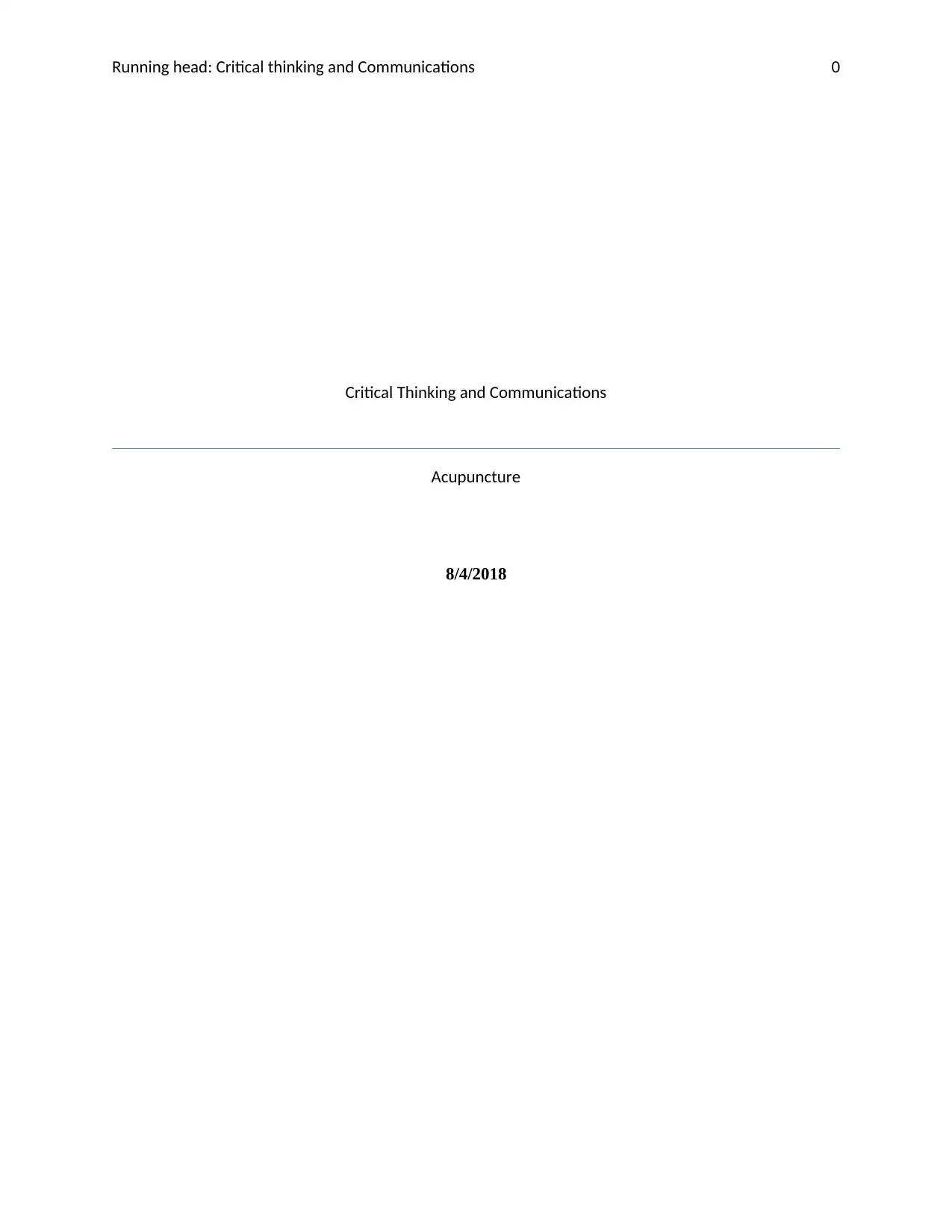
Running head: Critical thinking and Communications 0
Critical Thinking and Communications
Acupuncture
8/4/2018
Critical Thinking and Communications
Acupuncture
8/4/2018
Paraphrase This Document
Need a fresh take? Get an instant paraphrase of this document with our AI Paraphraser
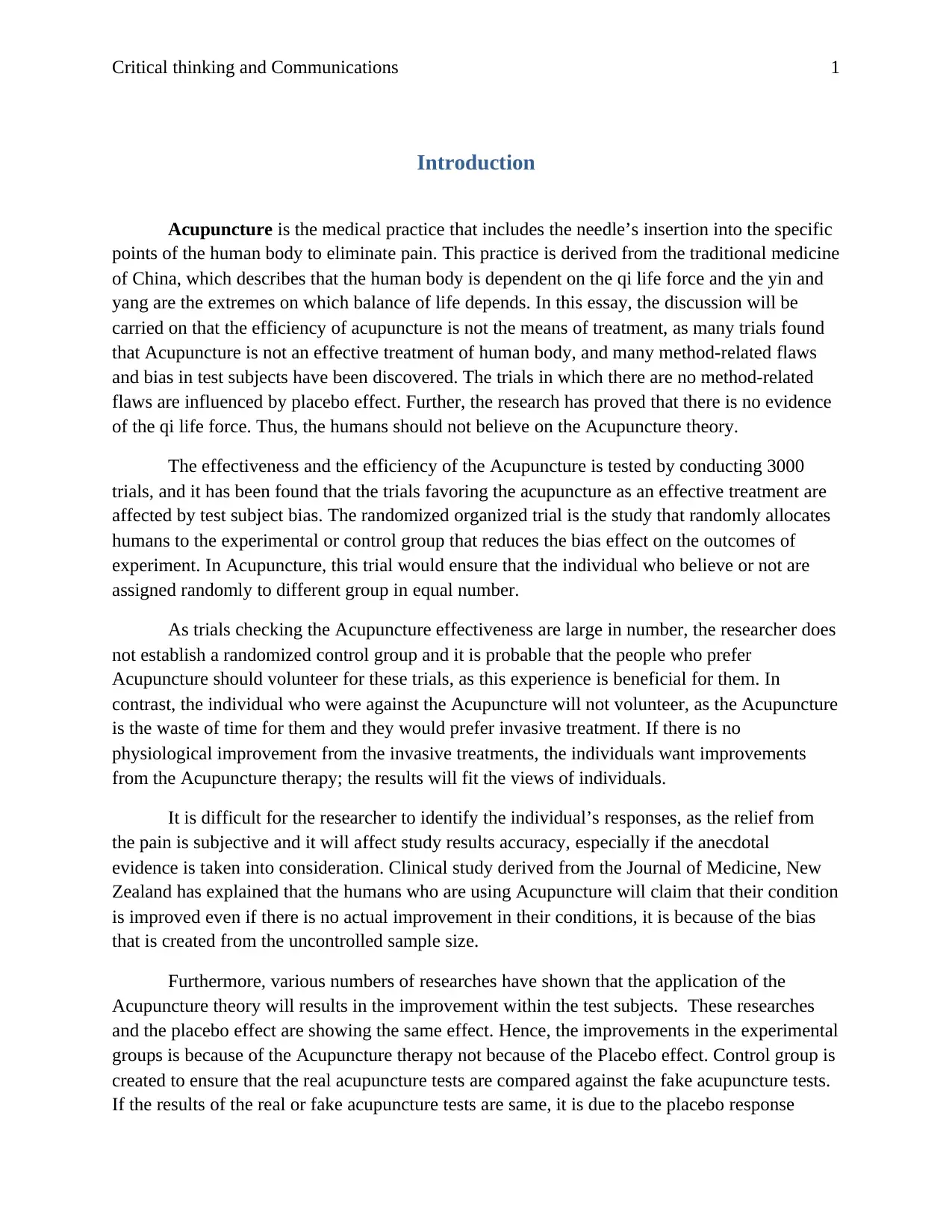
Critical thinking and Communications 1
Introduction
Acupuncture is the medical practice that includes the needle’s insertion into the specific
points of the human body to eliminate pain. This practice is derived from the traditional medicine
of China, which describes that the human body is dependent on the qi life force and the yin and
yang are the extremes on which balance of life depends. In this essay, the discussion will be
carried on that the efficiency of acupuncture is not the means of treatment, as many trials found
that Acupuncture is not an effective treatment of human body, and many method-related flaws
and bias in test subjects have been discovered. The trials in which there are no method-related
flaws are influenced by placebo effect. Further, the research has proved that there is no evidence
of the qi life force. Thus, the humans should not believe on the Acupuncture theory.
The effectiveness and the efficiency of the Acupuncture is tested by conducting 3000
trials, and it has been found that the trials favoring the acupuncture as an effective treatment are
affected by test subject bias. The randomized organized trial is the study that randomly allocates
humans to the experimental or control group that reduces the bias effect on the outcomes of
experiment. In Acupuncture, this trial would ensure that the individual who believe or not are
assigned randomly to different group in equal number.
As trials checking the Acupuncture effectiveness are large in number, the researcher does
not establish a randomized control group and it is probable that the people who prefer
Acupuncture should volunteer for these trials, as this experience is beneficial for them. In
contrast, the individual who were against the Acupuncture will not volunteer, as the Acupuncture
is the waste of time for them and they would prefer invasive treatment. If there is no
physiological improvement from the invasive treatments, the individuals want improvements
from the Acupuncture therapy; the results will fit the views of individuals.
It is difficult for the researcher to identify the individual’s responses, as the relief from
the pain is subjective and it will affect study results accuracy, especially if the anecdotal
evidence is taken into consideration. Clinical study derived from the Journal of Medicine, New
Zealand has explained that the humans who are using Acupuncture will claim that their condition
is improved even if there is no actual improvement in their conditions, it is because of the bias
that is created from the uncontrolled sample size.
Furthermore, various numbers of researches have shown that the application of the
Acupuncture theory will results in the improvement within the test subjects. These researches
and the placebo effect are showing the same effect. Hence, the improvements in the experimental
groups is because of the Acupuncture therapy not because of the Placebo effect. Control group is
created to ensure that the real acupuncture tests are compared against the fake acupuncture tests.
If the results of the real or fake acupuncture tests are same, it is due to the placebo response
Introduction
Acupuncture is the medical practice that includes the needle’s insertion into the specific
points of the human body to eliminate pain. This practice is derived from the traditional medicine
of China, which describes that the human body is dependent on the qi life force and the yin and
yang are the extremes on which balance of life depends. In this essay, the discussion will be
carried on that the efficiency of acupuncture is not the means of treatment, as many trials found
that Acupuncture is not an effective treatment of human body, and many method-related flaws
and bias in test subjects have been discovered. The trials in which there are no method-related
flaws are influenced by placebo effect. Further, the research has proved that there is no evidence
of the qi life force. Thus, the humans should not believe on the Acupuncture theory.
The effectiveness and the efficiency of the Acupuncture is tested by conducting 3000
trials, and it has been found that the trials favoring the acupuncture as an effective treatment are
affected by test subject bias. The randomized organized trial is the study that randomly allocates
humans to the experimental or control group that reduces the bias effect on the outcomes of
experiment. In Acupuncture, this trial would ensure that the individual who believe or not are
assigned randomly to different group in equal number.
As trials checking the Acupuncture effectiveness are large in number, the researcher does
not establish a randomized control group and it is probable that the people who prefer
Acupuncture should volunteer for these trials, as this experience is beneficial for them. In
contrast, the individual who were against the Acupuncture will not volunteer, as the Acupuncture
is the waste of time for them and they would prefer invasive treatment. If there is no
physiological improvement from the invasive treatments, the individuals want improvements
from the Acupuncture therapy; the results will fit the views of individuals.
It is difficult for the researcher to identify the individual’s responses, as the relief from
the pain is subjective and it will affect study results accuracy, especially if the anecdotal
evidence is taken into consideration. Clinical study derived from the Journal of Medicine, New
Zealand has explained that the humans who are using Acupuncture will claim that their condition
is improved even if there is no actual improvement in their conditions, it is because of the bias
that is created from the uncontrolled sample size.
Furthermore, various numbers of researches have shown that the application of the
Acupuncture theory will results in the improvement within the test subjects. These researches
and the placebo effect are showing the same effect. Hence, the improvements in the experimental
groups is because of the Acupuncture therapy not because of the Placebo effect. Control group is
created to ensure that the real acupuncture tests are compared against the fake acupuncture tests.
If the results of the real or fake acupuncture tests are same, it is due to the placebo response
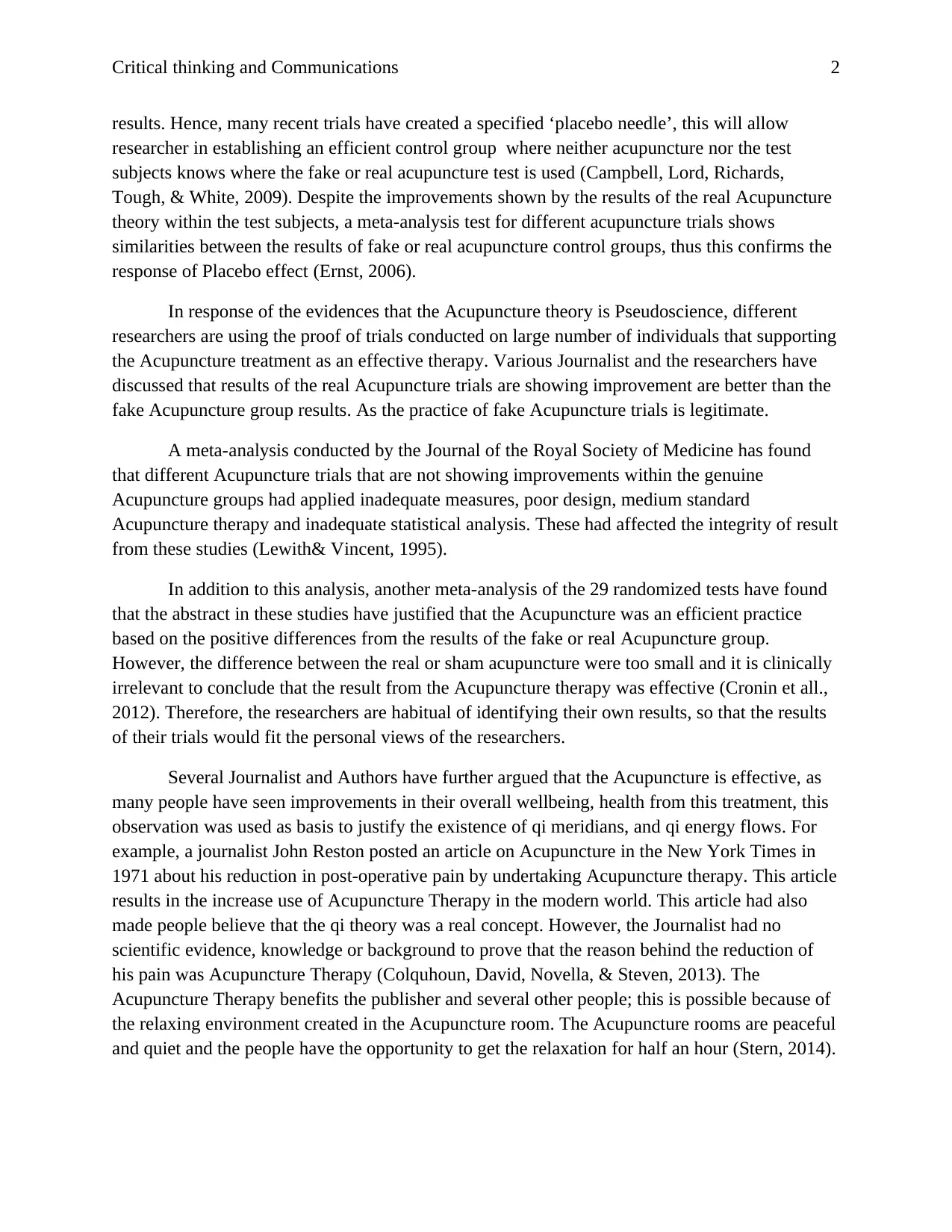
Critical thinking and Communications 2
results. Hence, many recent trials have created a specified ‘placebo needle’, this will allow
researcher in establishing an efficient control group where neither acupuncture nor the test
subjects knows where the fake or real acupuncture test is used (Campbell, Lord, Richards,
Tough, & White, 2009). Despite the improvements shown by the results of the real Acupuncture
theory within the test subjects, a meta-analysis test for different acupuncture trials shows
similarities between the results of fake or real acupuncture control groups, thus this confirms the
response of Placebo effect (Ernst, 2006).
In response of the evidences that the Acupuncture theory is Pseudoscience, different
researchers are using the proof of trials conducted on large number of individuals that supporting
the Acupuncture treatment as an effective therapy. Various Journalist and the researchers have
discussed that results of the real Acupuncture trials are showing improvement are better than the
fake Acupuncture group results. As the practice of fake Acupuncture trials is legitimate.
A meta-analysis conducted by the Journal of the Royal Society of Medicine has found
that different Acupuncture trials that are not showing improvements within the genuine
Acupuncture groups had applied inadequate measures, poor design, medium standard
Acupuncture therapy and inadequate statistical analysis. These had affected the integrity of result
from these studies (Lewith& Vincent, 1995).
In addition to this analysis, another meta-analysis of the 29 randomized tests have found
that the abstract in these studies have justified that the Acupuncture was an efficient practice
based on the positive differences from the results of the fake or real Acupuncture group.
However, the difference between the real or sham acupuncture were too small and it is clinically
irrelevant to conclude that the result from the Acupuncture therapy was effective (Cronin et all.,
2012). Therefore, the researchers are habitual of identifying their own results, so that the results
of their trials would fit the personal views of the researchers.
Several Journalist and Authors have further argued that the Acupuncture is effective, as
many people have seen improvements in their overall wellbeing, health from this treatment, this
observation was used as basis to justify the existence of qi meridians, and qi energy flows. For
example, a journalist John Reston posted an article on Acupuncture in the New York Times in
1971 about his reduction in post-operative pain by undertaking Acupuncture therapy. This article
results in the increase use of Acupuncture Therapy in the modern world. This article had also
made people believe that the qi theory was a real concept. However, the Journalist had no
scientific evidence, knowledge or background to prove that the reason behind the reduction of
his pain was Acupuncture Therapy (Colquhoun, David, Novella, & Steven, 2013). The
Acupuncture Therapy benefits the publisher and several other people; this is possible because of
the relaxing environment created in the Acupuncture room. The Acupuncture rooms are peaceful
and quiet and the people have the opportunity to get the relaxation for half an hour (Stern, 2014).
results. Hence, many recent trials have created a specified ‘placebo needle’, this will allow
researcher in establishing an efficient control group where neither acupuncture nor the test
subjects knows where the fake or real acupuncture test is used (Campbell, Lord, Richards,
Tough, & White, 2009). Despite the improvements shown by the results of the real Acupuncture
theory within the test subjects, a meta-analysis test for different acupuncture trials shows
similarities between the results of fake or real acupuncture control groups, thus this confirms the
response of Placebo effect (Ernst, 2006).
In response of the evidences that the Acupuncture theory is Pseudoscience, different
researchers are using the proof of trials conducted on large number of individuals that supporting
the Acupuncture treatment as an effective therapy. Various Journalist and the researchers have
discussed that results of the real Acupuncture trials are showing improvement are better than the
fake Acupuncture group results. As the practice of fake Acupuncture trials is legitimate.
A meta-analysis conducted by the Journal of the Royal Society of Medicine has found
that different Acupuncture trials that are not showing improvements within the genuine
Acupuncture groups had applied inadequate measures, poor design, medium standard
Acupuncture therapy and inadequate statistical analysis. These had affected the integrity of result
from these studies (Lewith& Vincent, 1995).
In addition to this analysis, another meta-analysis of the 29 randomized tests have found
that the abstract in these studies have justified that the Acupuncture was an efficient practice
based on the positive differences from the results of the fake or real Acupuncture group.
However, the difference between the real or sham acupuncture were too small and it is clinically
irrelevant to conclude that the result from the Acupuncture therapy was effective (Cronin et all.,
2012). Therefore, the researchers are habitual of identifying their own results, so that the results
of their trials would fit the personal views of the researchers.
Several Journalist and Authors have further argued that the Acupuncture is effective, as
many people have seen improvements in their overall wellbeing, health from this treatment, this
observation was used as basis to justify the existence of qi meridians, and qi energy flows. For
example, a journalist John Reston posted an article on Acupuncture in the New York Times in
1971 about his reduction in post-operative pain by undertaking Acupuncture therapy. This article
results in the increase use of Acupuncture Therapy in the modern world. This article had also
made people believe that the qi theory was a real concept. However, the Journalist had no
scientific evidence, knowledge or background to prove that the reason behind the reduction of
his pain was Acupuncture Therapy (Colquhoun, David, Novella, & Steven, 2013). The
Acupuncture Therapy benefits the publisher and several other people; this is possible because of
the relaxing environment created in the Acupuncture room. The Acupuncture rooms are peaceful
and quiet and the people have the opportunity to get the relaxation for half an hour (Stern, 2014).
⊘ This is a preview!⊘
Do you want full access?
Subscribe today to unlock all pages.

Trusted by 1+ million students worldwide
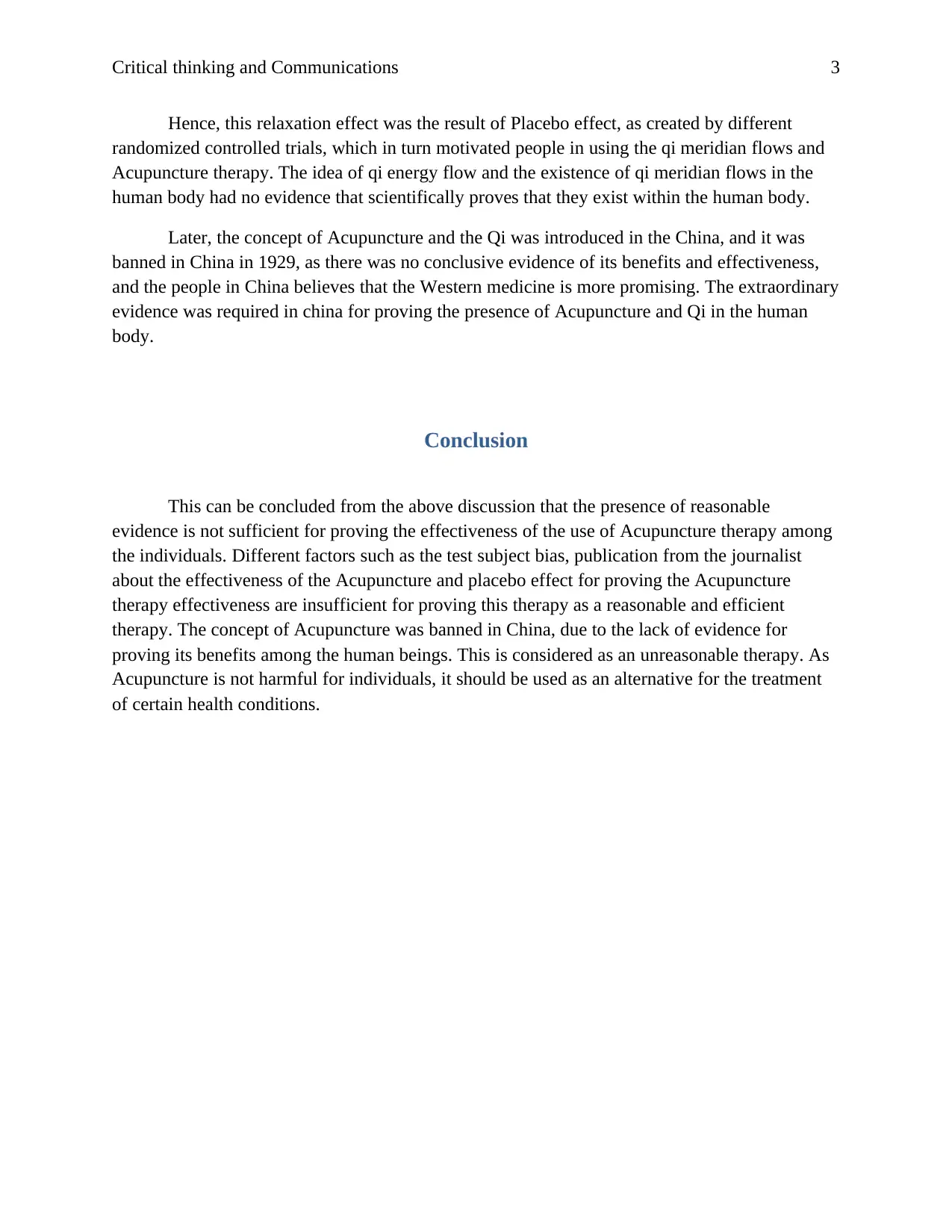
Critical thinking and Communications 3
Hence, this relaxation effect was the result of Placebo effect, as created by different
randomized controlled trials, which in turn motivated people in using the qi meridian flows and
Acupuncture therapy. The idea of qi energy flow and the existence of qi meridian flows in the
human body had no evidence that scientifically proves that they exist within the human body.
Later, the concept of Acupuncture and the Qi was introduced in the China, and it was
banned in China in 1929, as there was no conclusive evidence of its benefits and effectiveness,
and the people in China believes that the Western medicine is more promising. The extraordinary
evidence was required in china for proving the presence of Acupuncture and Qi in the human
body.
Conclusion
This can be concluded from the above discussion that the presence of reasonable
evidence is not sufficient for proving the effectiveness of the use of Acupuncture therapy among
the individuals. Different factors such as the test subject bias, publication from the journalist
about the effectiveness of the Acupuncture and placebo effect for proving the Acupuncture
therapy effectiveness are insufficient for proving this therapy as a reasonable and efficient
therapy. The concept of Acupuncture was banned in China, due to the lack of evidence for
proving its benefits among the human beings. This is considered as an unreasonable therapy. As
Acupuncture is not harmful for individuals, it should be used as an alternative for the treatment
of certain health conditions.
Hence, this relaxation effect was the result of Placebo effect, as created by different
randomized controlled trials, which in turn motivated people in using the qi meridian flows and
Acupuncture therapy. The idea of qi energy flow and the existence of qi meridian flows in the
human body had no evidence that scientifically proves that they exist within the human body.
Later, the concept of Acupuncture and the Qi was introduced in the China, and it was
banned in China in 1929, as there was no conclusive evidence of its benefits and effectiveness,
and the people in China believes that the Western medicine is more promising. The extraordinary
evidence was required in china for proving the presence of Acupuncture and Qi in the human
body.
Conclusion
This can be concluded from the above discussion that the presence of reasonable
evidence is not sufficient for proving the effectiveness of the use of Acupuncture therapy among
the individuals. Different factors such as the test subject bias, publication from the journalist
about the effectiveness of the Acupuncture and placebo effect for proving the Acupuncture
therapy effectiveness are insufficient for proving this therapy as a reasonable and efficient
therapy. The concept of Acupuncture was banned in China, due to the lack of evidence for
proving its benefits among the human beings. This is considered as an unreasonable therapy. As
Acupuncture is not harmful for individuals, it should be used as an alternative for the treatment
of certain health conditions.
Paraphrase This Document
Need a fresh take? Get an instant paraphrase of this document with our AI Paraphraser
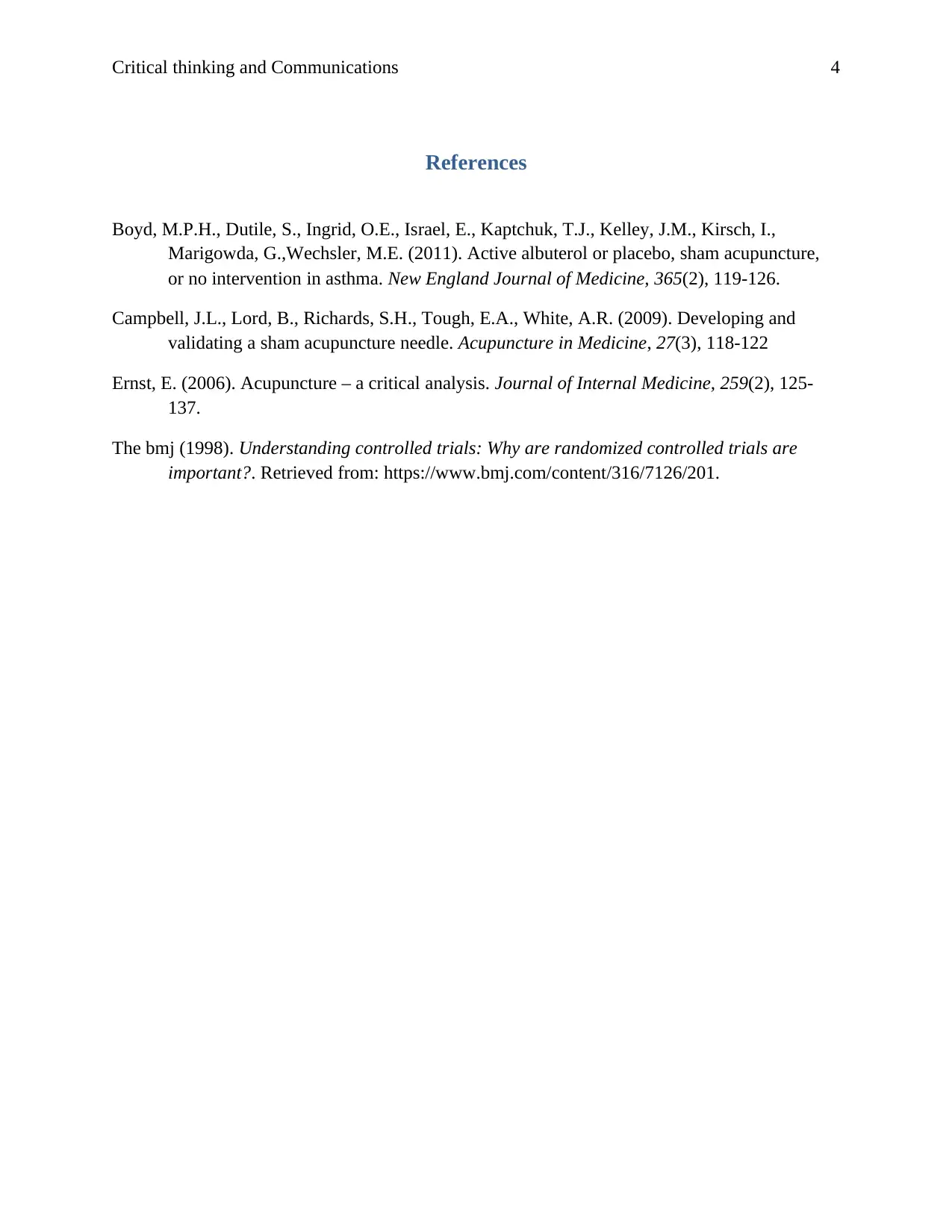
Critical thinking and Communications 4
References
Boyd, M.P.H., Dutile, S., Ingrid, O.E., Israel, E., Kaptchuk, T.J., Kelley, J.M., Kirsch, I.,
Marigowda, G.,Wechsler, M.E. (2011). Active albuterol or placebo, sham acupuncture,
or no intervention in asthma. New England Journal of Medicine, 365(2), 119-126.
Campbell, J.L., Lord, B., Richards, S.H., Tough, E.A., White, A.R. (2009). Developing and
validating a sham acupuncture needle. Acupuncture in Medicine, 27(3), 118-122
Ernst, E. (2006). Acupuncture – a critical analysis. Journal of Internal Medicine, 259(2), 125-
137.
The bmj (1998). Understanding controlled trials: Why are randomized controlled trials are
important?. Retrieved from: https://www.bmj.com/content/316/7126/201.
References
Boyd, M.P.H., Dutile, S., Ingrid, O.E., Israel, E., Kaptchuk, T.J., Kelley, J.M., Kirsch, I.,
Marigowda, G.,Wechsler, M.E. (2011). Active albuterol or placebo, sham acupuncture,
or no intervention in asthma. New England Journal of Medicine, 365(2), 119-126.
Campbell, J.L., Lord, B., Richards, S.H., Tough, E.A., White, A.R. (2009). Developing and
validating a sham acupuncture needle. Acupuncture in Medicine, 27(3), 118-122
Ernst, E. (2006). Acupuncture – a critical analysis. Journal of Internal Medicine, 259(2), 125-
137.
The bmj (1998). Understanding controlled trials: Why are randomized controlled trials are
important?. Retrieved from: https://www.bmj.com/content/316/7126/201.
1 out of 5
Related Documents
Your All-in-One AI-Powered Toolkit for Academic Success.
+13062052269
info@desklib.com
Available 24*7 on WhatsApp / Email
![[object Object]](/_next/static/media/star-bottom.7253800d.svg)
Unlock your academic potential
Copyright © 2020–2025 A2Z Services. All Rights Reserved. Developed and managed by ZUCOL.




